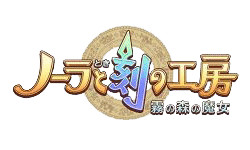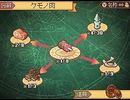|
|

|
PLATFORM
|
DS
|
BATTLE SYSTEM
|

|
INTERACTION
|

|
ORIGINALITY
|

|
STORY
|

|
MUSIC & SOUND
|

|
VISUALS
|

|
CHALLENGE
|
Easy
|
LANGUAGE BARRIER
|
Moderate
|
COMPLETION TIME
|
Less than 20 Hours
|
|
OVERALL

|
+ Good cast of characters.
+ Well balanced soundtrack.
+ Allows for home customization...
- ...but a little cumbersome with item placement.
- Easy until it's not.
- Only three years?!
|
Click here for scoring definitions
|
|
|
Until recently, collaborative efforts between video game companies were fairly rare. When it was announced that Gust and Atlus would team up for a DS title, it was hard to say how it might turn out. With the minds behind Etrian Odyssey and Atelier Marie on the job, things could get interesting. As it turned out, the resulting game is much more like its Atelier cousins. Noora to Toki no Koubou: Kiri no Mori no Majou isn't the easiest title to translate, as the second word, toki, is intentionally made to carry multiple meanings that can't be conveyed properly in English, at least not simultaneously. For the rest of the review, we'll simply be referring to the game as Nora's Studio.
The game's secondary title means "The Witch of the Misty Woods," a reference to a local fairy tale. Unfortunately, the witch in the story was mean and nasty, and the game's heroine, Nora, just happens to live in the Misty Woods with her little assistant, Keke. She's got actual magic powers, but according to the rules of her people, she's not allowed to reveal their existence for three years as she tries to make her way in the outside world. The locals are quick to put two and two together to make five (or WITCH!), however, and from the start it's an uphill battle for Nora to gain anyone's trust. Children run away from her as she walks through town, shopkeepers refuse to deal with her, and the mayor hurls invective at every opportunity. This need to build trust and friendship lies at the heart of the game's character development, as each of the game's eight human party members has his or her own stories to explore and endings to unlock. The Normal and True endings are also interesting in that Nora is presented with a moral choice, to stand her ground or to run, and the ending plays out differently depending on the choices made.
Even a quick look over the gameplay should tell the player that the title could well have said "Atelier" instead of "Studio." Many of the gameplay elements, from the requests and item creation to the three year time limit, were definitely lifted from that series. Conversely, some of the biggest differences were to be found in those same elements. Nora's gimmick is the ability to control the flow of time, artificially aging or regressing items until they reach the desired state. That's only one-third of what Nora can do, however. With the proper tools, she can build a lot of items, and to get the raw materials she must break down things she picks up in the field into more usable bits. For example, Wild Meat isn't really usable on its own, but Nora can easily render it into usable meat, hide, bones, and Chrono Essence. This last is a common by-product of the rendering process, and a necessary item as it, in its various flavors, is needed to run Nora's time-spinning apparatus.
Nora can access all this just by pressing "A" in front of the Time Spinner, but as the number of known items increases, this interface becomes more and more cluttered. As an alternative, the player can place tools and furniture around her house, each with a specific menu use. The desk can be used to directly access the save menu, while the bookshelf houses the reference section. Kitchen implements let the player work with food items only, while the carpentry tools focus on woodworking. The player can place these tools anywhere within Nora's home and use them to quickly find any item recipe required. A large number of items serve only to expand Nora's storage capacity. It's also possible to change the floors and walls, plant flowers in the yard, or even convince stray pets to stick around.
Pets are the only items that carry over between games, by the way. They come in seven species, six of which have color variants. Dogs, cats, parrots, ducks, and baby dragons are all available, as are big and small varieties of kakukoro (Cubicks), the game's mascot monsters.
 Getting Ready for Dinner
Getting Ready for Dinner
|
|
As she is a heroine in the "meister" sub-genre, Nora has to do a lot of foraging to get what she wants. There are nine areas for her to explore, most with secondary areas that can be unlocked via different character events. The foraging interface is interesting in that it resembles what Atelier Lise was supposed to be like before the original build for that game was dumped. Against the area backdrop, icons representing different sorts of items appear. These can be selected with the cursor buttons or the touchpen. Any number of these icons may have a special bonus (not always good) attached. The current bonuses at large in an area are visible in the top-right corner of the screen, and the icons with bonuses will glitter a little if one looks at them long enough. There's nothing to indicate which bonus goes with which icon, however, and they range from things like "increased value" and "more volume" to negative traits like "higher encounter rate" and "major monster attack." It takes a day to harvest each icon, and Nora can choose to reset the area once at the cost of another day. On the other hand, simply traveling between points on the map takes no time on the calendar, and returning to Nora's house from an adventure area only takes one day. Compared to most of the Atelier games, time management in Nora's Studio is pretty easy to deal with.
Combat in Nora's Studio also follows the Atelier model in many ways. Three members to a party, three rows in the battle formation, and a few skills for each character. The battle system does what it's supposed to do, and does it well. It just isn't the defining part of the game. Skill points recharge after each fight, so the player is free to use the good attacks regularly, and there's a variety of useful items to help one through tougher battles. The three optional bosses are all satisfyingly difficult but not impossible with good preparations.
The art and locales were the work of Yuji Himukai, of Etrian fame. There are splash pages associated with each of the main characters that can be viewed in the game's Extras section once they've been unlocked. The cast members all have different expressive poses for their portraits, and overall possess looks that communicate their personalities well.
 Mad Cow Alert!
Mad Cow Alert!
|
|
Likewise, the game's fifty tracks of background music all support it beautifully. Each of the character tracks reflects the personality of its associated character, and the five generic event tracks set the appropriate moods. Every locale in the game has atmospheric BGM tailored to it, and the three individual boss battle tracks rock out.
The difficulty level in this game is hard to pin down, as it can vary a lot depending on which characters and requests the player chooses. Two characters, Ruttz and Karuna, have to take down boss monsters in order to see their specific endings, and to do this will require a fair amount of preparation. Likewise, some of the requests presented to Nora can be very difficult. Fortunately the jobs that are actually required to move a character's story onward are pretty easy. Nora has to do jobs to build up the good will meter, but that does not mean that she has to do every single job that Davy the barman offers. The actual amount of Japanese ability needed to play this game is fairly low, but any enterprising foreign players will have to have a good eye for kanji and kana to get through the item-creation interface. The ability to access only parts of the item list through individual tools (mentioned above) helps a lot, however.
Nora's Studio is not a long game by any means. A single playthrough should take less than ten hours. With eight character-specific endings, however, it was definitely intended for multiple playthroughs. There is simply no way to see everything in the game without doing so. I finished it three times before I even began this review, and I shall probably play it a few more times this year. Like its Atelier cousins, Nora's Studio may not be the most epic of tales, but it does a very good job with what it's got.
Review Archives
|









